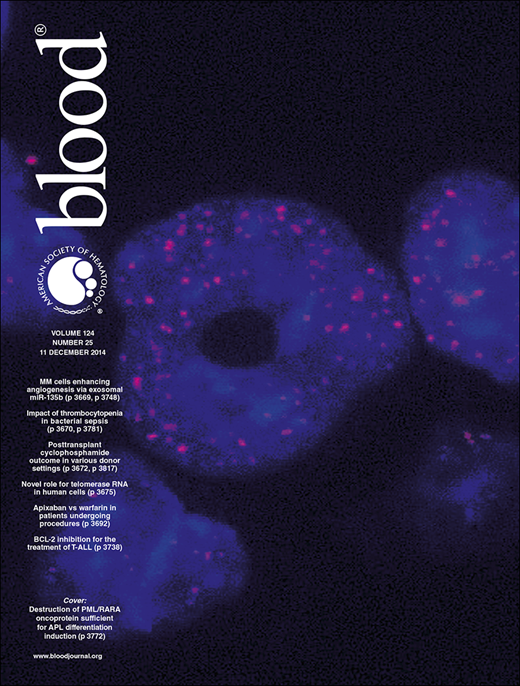To the editor:
Acute megakaryocytic leukemia (AMegL) is a rare subtype of acute myeloid leukemia (AML), resulting from uncontrolled proliferation of primitive megakaryoblasts in the bone marrow.1 The disease, first described by Von Boros and colleagues in 1931, was incorporated into the French-American-British (FAB) classification in 1985 and designated as AML M7.2 AMegL has a bimodal distribution, occurring in children between 1 and 3 years of age, particularly those with Down syndrome.3 Among adults, AMegL is much more rare, occurring in only ∼0.6% of all AML cases.4 Owing to the rarity of this condition, there are limited data on the natural history, treatment, and prognosis of this disease.
We used the Surveillance, Epidemiology, and End Results (SEER) 18 database to identify adult patients with AML diagnosed between 1991 and 2011, using appropriate International Classification of Disease (ICD-O-3) histology codes.5 Cases of acute promyelocytic leukemia (M3) were excluded from all analysis. Kaplan-Meier survival curves were generated to compare survival statistics between the AMegL subtype and the rest of AML types. Multivariate analysis was done using the Cox linear proportional hazard regression model. Statistical analysis was done using Statistical Package of Social Sciences (SPSS) version 21.0 (IBM Corporation).
Of 45 564 cases of AML identified, 304 (0.7%) belonged to the AMegL subtype. The median age was 69 years in non-M7 AML (range, 18-111 years) as compared with 67.5 years (range, 18-92 years) in AMegL, respectively (P = .08); the proportion of men was 54.3% and 59.2%, respectively, in the 2 groups (P = .09). Whites comprised 82.6% and 84.7% of the cases of non-M7 AML and AMegL, respectively. The 5-year overall survival rates were 17.5% and 10.6% in the non-M7 AML and AMegL, respectively. The Kaplan-Meier survival curve showed significantly worsened survival of the AMegL subtype as compared with rest of the AML cases (P value of log-rank test <.01). On multivariate analysis, the AMegL subtype was as an independent predictor of increased mortality (adjusted relative risk [RR], 1.23; 95% confidence interval [CI], 1.09-1.38; P = .001), after adjusting for age of diagnosis, sex, race, and year of diagnosis (Table 1). This remained significant, even after removing the core-binding factor leukemia cases from the analysis (RR, 1.21; 95% CI, 1.07-1.36; P = .001).
Our population-based study demonstrates that AMegL is an independent prognostic factor for poor survival among patients with AML. Our findings are in agreement with a prior study from the MD Anderson Cancer Center that had shown AMegL to be an independent adverse prognostic factor for overall survival, independent of cytogenetic abnormalities.2 AMegL comprised 0.7% of the total cases of AML in our study, which was comparable to the prevalence reported by prior published series (0.6%-2%).1,2,4 Also, the median age of 67.5 years in our study was somewhat higher than those of prior published series (42.5-58 years). This is likely because those series come from clinical trial data, which usually comprise younger, healthier patients.1,2,4,6
Through a population-based approach, we have attempted to overcome the sample size limitations of prior series on adults with AMegL. However, our study has several important limitations. SEER is a deidentified database, hence the accuracy of coding cannot be individually verified. Also, SEER data lack information on chemotherapy usage, which was not separately analyzed. Similarly, the limitations of this database prohibited us from controlling other prognostic factors such as patient comorbidities, performance status, and cytogenetic and molecular abnormalities with prognostic significance in our multivariate analysis.
In conclusion, our study adds to the existing evidence that AMegL is an independent poor prognostic factor among adults with AML. We recommend that the National Comprehensive Cancer Network (NCCN) consider adding AMegL morphology to the list of adverse prognostic factors and as a reason to consider allogeneic stem cell transplantation.
Authorship
Acknowledgments: This study used the SEER database. The interpretation of these data are the sole responsibility of the authors. The authors acknowledge the efforts of the New York State Cancer Registry, New York State Department of Health, and the SEER program tumor registries in the creation of the SEER database.
Contribution: S.G. and M.G.M. conceived and designed the study; S.G. and R.P. analyzed the data; S.G., B.L., and P.P. wrote the manuscript; and all authors contributed to the revisions of the manuscript.
Conflict-of-interest disclosure: The authors declare no competing financial interests.
Correspondence: Smith Giri, Department of Medicine, The University of Tennessee Health Science Center, 956 Court Ave, Room H314, Memphis, TN 38163; e-mail: smithgiri963@gmail.com.

